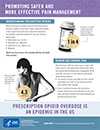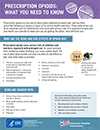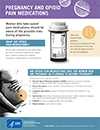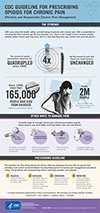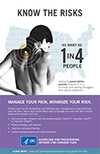Helpful Materials for Patients
Chronic Pain
Living with chronic pain can be challenging. It is essential that you and your doctor discuss treatment options with all of the risks and benefits carefully considered. Some medications, such as prescription opioids, can help relieve pain in the short term but also come with serious risks and potential complications—and must be prescribed and used carefully. CDC’s Guideline for Prescribing Opioids for Chronic Pain helps increase providers’ ability to offer safer, more effective pain management. The Guideline and supporting resources support clinical decision making about prescribing opioids.
Even When Prescribed by a Doctor
Informational, 91-second video that raises awareness about prescription opioids.
Some people might think prescription opioids are safer than alcohol or illegal drugs, but the truth is they carry serious risks and side effects. Talk with your doctor about your concerns and make informed decisions about pain management together.
Acute Pain
Acute Pain is pain that usually starts suddenly and has a known cause, like an injury or surgery. It normally gets better as your body heals and lasts less than three months. For this type of pain, opioid prescriptions should only be for the expected duration of pain severe enough to need opioids. Three days or less is often enough; more than seven days is rarely needed.
Even When Prescribed by a Doctor
Informational, 91-second video that raises awareness about prescription opioids.
Some people might think prescription opioids are safer than alcohol or illegal drugs, but the truth is they carry serious risks and side effects. Talk with your doctor about your concerns and make informed decisions about pain management together.
Additional Resources
- FDA: Disposal of Unused Medicines: What You Should Know
- U.S. Department of Health and Human Services Poison Help Hotline: 1-800-222-1222.
Find Help and Treatment
If you or someone close to you needs help for a substance use disorder, talk to your doctor or call SAMHSA’s National Helpline at 1-800-662-HELP or go to SAMHSA’s Behavioral Health Treatment Services Locator.
- Page last reviewed: August 31, 2017
- Page last updated: August 31, 2017
- Content source:
- Centers for Disease Control and Prevention,
- National Center for Injury Prevention and Control,
- Division of Unintentional Injury Prevention


 ShareCompartir
ShareCompartir
